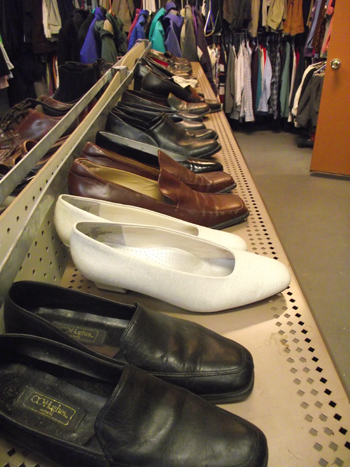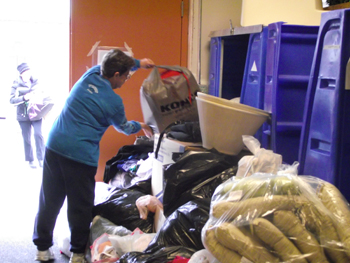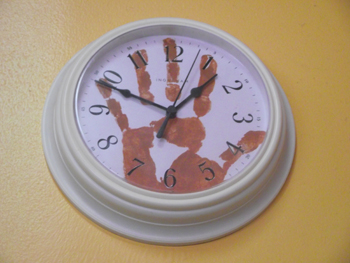Friday’s Top Hits Karaoke event gave students and residents of the Citizens of the World house an opportunity to take to the stage and perform songs in their native languages.
Top Hits Karaoke was the house project of sophomore Emmy Chien, a member of COW house. Chien says she decided to hold an international karaoke night to bring her hobbies from her home in Taiwan to American soil.
“I go to Karaoke once a week with my friends back in Thailand, so I want to introduce my hobby to OWU,” she said. “Because COW House is an international house, I found the Mike Karaoke System that includes English, Chinese, Taiwanese, Spanish, Japanese and Korean songs, which allows students from different countries to participate.”
Only about fifteen to twenty students attended the event, but Chien said there was no lack of spirit despite the intimate audience. With clapping, singing, screaming and dancing, she said if there was a shy performer, it did not take long for him or her to warm right up.
The confidence exuded by performers could be attributed in part to their pride in their nationality.
“COW house emphasizes the globalization of the world, so by gathering students from different countries to sing out their heart, we all get to know each other more,” Chien said.
“The diverse environment provided by COW house was highlighted through this event because without the diversity in house members, the event would not have been successful.”
Chien said junior Ashley Madera, the house moderator, noticed diversity among performers was not limited simply to their languages, but was also shown in their individual song selection. While American students gravitated towards poppy tunes, the Chinese students sang slower ballads.
“The way the American students interact when singing was also different than when the Chinese students sang,” Chien said. “It was like team work when the American students sang a song they all know; they shared the two microphones, clapped and danced. Amongst the Chinese students, only two students sang and the others listened.”
Freshman Kerrigan Boyd said the event was a fun way to learn about different cultures and recognize the true diversity on OWU’s campus.
“It was really cool because people did songs in Chinese and people could see the words on the screen,” she said. “It put a fun twist on the whole thing.”
Madera agreed with Boyd, saying she appreciated the “true talent” of the performers.
“I am always amazed at how comfortable some people feel in front of the microphone and this event was no exception,” Madera said. “Some people would be surprised to know that some of the guys on campus have amazing voices.”
As the COW house moderator, Madera realized how connected the event was to the house’s mission statement.
“I think this event was a great kick-off to the upcoming events for the Citizens of the World House this semester,” she said. “I think it truly embodied our mission to immerse cultures from around the world in an activity we are all familiar with.”
Category: News
Greek of the Week
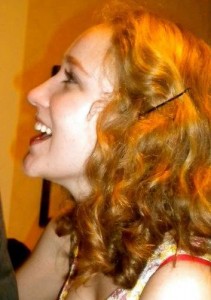
Laurel Fuller
Kappa Kappa Gamma
After a successful night of philanthropy fun, sophomore Laurel Fuller is The Transcript’s first Greek of the Week. This member of Kappa Kappa Gamma recently planned Kappa Karaoke, an event that included all of the fraternities and sororities as participants in a karaoke contest to help raise money for Kappa’s philanthropy, “Reading in Fundamental.” Fuller can not only handle planning Greek events on campus, but she also has control of the wheel of her car, as she has driven across the entire country.
Students step on stage to have a ball Rehearsals under way for OWU theatre production Ring Round the Moon
Students in the Theatre Department are busy with rehearsals for the upcoming spring production Ring Round the Moon premiering on April 13 on the main stage in the Chappelear Drama Center.
Ring Round the Moon is a parody of upper-class vanity adapted by the eminent British playwright Christopher Fry based on Jean Anouilh’s L’Invitation.
The play is being directed by Dr. Ed Kahn, associate professor of Theatre & Dance. Kahn is being assisted by junior theatre major Leah Shaeffer.
Shaffer said she is looking forward to the production.
She said the cast and crew will surly make it a spectacular show and not only on stage.
“We have some big ideas for decorating the entire theatre for the show,” said Shaeffer.
“On stage, we are planning on having a working fountain, carefully sculpted topiaries and glowing lanterns strung over the audience.”
Shaffer said in addition to the wonderful acting, it is going to be a visual beautifully production.
Ring Round the Moon is different than most productions put on by the theatre department.
In the play, several wealthy individuals attend a French high-society ball, but most of them are unaware that there are several elaborate schemes and pranks going on behind the scenes.
As the night unfolds and turns to dawn, the party gets crazier and crazier.The chateau is presided over by the wheelchair-bound chatelaine, Madame Desmortes, who has identical twin nephews. Both twins are played by junior Matthew Jamison.
Kind-hearted and innocent Fredrick is engaged to a rich heiress who actually loves Frederic’s cold-hearted brother, Hugo.
Hugo knows Fredrick’s marriage will be a disaster and attempts to disentangle the engagement.
Senior Misa Farslow is one of the leads in the play.
She said the witty play is different than anything she has ever acted in before.
“It is a really happy play with a happy ending, although it is not the ending most would expect.”
Shaeffer said working on Ring Round the Moon will be a unique experience for her as a theatre major.
“I have not worked on many translations before,” she said. “It is also broken into three acts rather than two, which is unusual compared to most plays I’ve worked on.”
She said it is a very funny play.
“(It’s) probably the most comedic play I’ve ever worked on.”
Ring Round the Moon will premier at OWU on April 13, 15, 20, 21 and 22 on the main stage in the Chappelear Drama Center.
College Republicans given a voice on liberal campus
Around the nation there is a myth that the youth of America leans to the left and votes blue.
But, even on the Ohio Wesleyan campus, which many consider to be extremely liberal, young Republicans are adamant about their Republican values and continue to find hope in the red.
Though many consider themselves to be Republicans, the word is often used as an umbrella to classify a wide array of conservative beliefs.
College
Republicans
Sophomore Tim Alford is the President of OWU’s chapter of College Republicans.
Unlike the previous president of the club, Spencer Meads (’11), Alford is a Moderate Conservative.
He said he wants to defeat Obama in the 2012 election but his overarching goal is to make students aware of political issues and give them the information they need to make informed decisions.
Alford said he feels being a Republican is often looked at as a bad thing on the OWU campus but he is open to all political views and stresses the right for everyone to have a valued opinion.
Drew Peterson, Interim Assistant Director of Residential Life, is the staff adviser for the club.
Peterson was a member of College Republicans during his undergraduate studies and has been involved with the OWU chapter, as adviser, since 2008.
He said he became the club’s staff adviser because he wants students to gain an appreciation for participating in political activities.
“Many students no longer think of political work as a service to the public,” Peterson said. “While community service hours are on the rise, voting turnouts decline. I hope that students participating in politically affiliated groups can see some ways in which their involvement has a meaningful influence on the outcome of political events, local, state and/or national (levels).”
The club’s weekly meetings take place at 7:30 p.m. on Weds. nights in the Media Room in the basement of Welch hall.
A typical meeting consists of running through the previous week’s minutes, discussing upcoming events and doing any necessary planning, and talking about current issues.
Alford said state issues, such as Senate Bill 5, often spark interesting debates because members of the club have such different opinions on them.
He said debates go on as long as people want to stay and could last hours.
Alford said the club has been known for door knocking and working at call banks, but has worked hard this year to offer alternative ways for students to get involved.
“I’m not going to pressure people to do things they don’t want to do,” Alford said.
The club is currently planning a tour of the Ohio Statehouse with the OWU College Democrats.
The State
Representatives
During the Feb. 22 meeting, the club was visited by two representatives from the Ohio College Republican Federation: Co-Chairman Samuel Bain and Vice Chairman Jeremiah Wagner.
Bain
Bain is a senior at Sinclair Community College in Dayton.
“What I do at the state federation is work to energize and improve the College Republican chapters around the state,” Bain said.
Bain considers himself a strong conservative and said at this point in time the economy and job creation “affect people of all faiths, people of all races, and all political parties. Without jobs people’s lives cease to exist… as a result of this America suffers as a whole as well.”
Bain said he believes America’s economy can get back on track by cutting taxes, especially corporate taxes, and reducing the strenuous regulations on businesses.
He said he believes Mitt Romney, and his experience at Bain Capital, make him the most electable candidate among those in the GOP primary.
Wagner
Wagner is a senior at the Ohio State University. His goals as vice chairman is to give back to chapters around the state and serve as a positive role model.
Wagner considers himself a social conservative or neo-conservative.
He said his beliefs align well with those of candidate Rick Santorum and he will support him in the GOP primaries.
Wagner said during this election cycle the most important issues to him are the economy, job creation, and the moral fabric of the country.
“In this election you’ll drone up support by saying that you are pro-life… or by saying that you want the state out of the church but I don’t think it matters that much to most voter’s this time around,” Wagner said.
OWU
STUDENTS
The Libertarian
Jordan Grammer is a sophomore from California who considers himself to be a Libertarian.
Grammer said he finds himself caring most about fiscal policies and environmental issues, such as alternative energy.
“I lean to the left on environmental issues more than other conservatives I know,” Grammer said. “I want a realistic approach that solves the situation we’re in now.
Though Grammer belongs to the Jewish faith, he said he finds that it doesn’t affect his political stances other than social issues that have significant humanitarian importance.
Grammer said he will vote for Ron Paul during the GOP primaries and hopes Jon Huntsman will be his vice president.
“His experience in (foreign affairs) would be a good asset,” Grammer said.
The Moral
Conservative
Junior Allyson North is a Louisiana native who grew up with active Republican parents who she said taught her to think more conservatively.
North considers herself to be fairly conservative and favors many Republican leaders.
In the fall of 2011 North participated in the Wesleyan in Washington program where she interned for Sen. Rob Portman.
“I liked the way (Portman) handled his job and the way he presented himself,” North said.
North said job creation and the economy are the most important issues to her.
“We’re going to be out there very soon and I want to find a good job that I like, not just one that I find,” North said.
She said religion is extremely important to her and she tries to incorporate her religious beliefs into everyday life, including her political stances.
Though she is pro-life she said she doesn’t feel she has the right to tell others how to choose.
The Fiscal
Conservative
Anthony Lamoureux is a sophomore from Rhode Island.
In regards to political affiliations, he said he considers himself to be an Independent who leans to the right on fiscal policy and to the left on social issues.
One of the issues that weighs on his mind is the abuse of the Welfare system.
“Where I’m from the whole Welfare system is really abused,” Lamoureux said. “In my city the average person on Welfare has two TVs, is getting a new phone every time it comes out, and has all that new kind of stuff. I think that’s a complete abuse of the system.”
Lamoureux said though he cannot assume people on Welfare are not looking for jobs, he feels people who actively seek jobs would be able to find them.
“I was a 16-year-old when I was able to find a job,” Lamoureux said. “How is it that someone in their twenties or thirties, who has all of their time, not including school, is unable to find something?”
The Moderate
Senior Kate Raulin grew up in Maryland in a liberal community.
Her mother is a Democrat and though her father is a registered Republican he is not heavily involved in political affairs.
Raulin considers herself to be a Moderate Republican and finds it may have spurred from wanting to be different than those she grew up with.
During the summer of 2011, Raulin was an intern for Congressman Pat Tiberi.
Though most of her responsibilities were office duties, such as giving tours, answering phones, and sending mail, Raulin said she learned a lot and was able to see the different perspectives of constituents.
“Mainly, I learned that people don’t have as open minds as they think they do,” Raulin said.
Raulin said at this point she favors Romney over other candidates because of his experience dealing with economic policies, the issue she is most adamant about, and has the best chance to beat Obama.
She said she tries to avoid heated debates and wishes people would approach both sides of an issue instead of getting swept up by party affiliations.
“We all want happiness and health,” Raulin said. “We just have different ways of getting there. But the importance should be the solutions, not political parties.”
The Free
Thinking Republican
Tim Carney is a senior from New Jersey.
Though Carney classifies himself as a moderate, he said he likes to think of himself as a free-thinking Republican who sees the importance of bettering the economy and working to create jobs.
Carney said he thinks for himself on issues, rather than voting by party line, but has not voted for a Democrat since gaining the ability to vote.
As a Catholic, controversies such as the health care bill—which forces religious institutions to provide birth control to their employees—weigh heavily on his mind.
Carney said he believes President Obama has done a good job at getting the nation to discuss major issues—such as health care, the debt crisis, and social security—but has lacked the ability to implement effective policies dealing with these issues.
He said he will be voting for Mitt Romney and would like to see New Jersey Gov. Chris Christie elected as his vice president.
Carney said he plans to be politically active during the campaign season and will be working at a call center for Romney, who he hopes to work for after he graduates in May.
For more information on OWU College Republicans, contact OWUCRS@owu.edu
The 98 Percent: Catholic women, leaders speak to birth control issue
Ninety-eight percent.
It’s an elusive figure, one hoped for in absolutes. Politicians desperately want to win 98 percent of their electorate’s votes; doctors hope to diagnose with 98 percent accuracy; church leaders pray to get 98 percent of the public through their doors.
But they don’t usually get that 98 percent. Politicians settle for anything more than half, and doctors go through round after round of treatments until they find the one that works. Even Christ himself couldn’t make followers out of 98 percent of his contemporaries.
And yet when it comes to American Catholic women and sexual experience, 98 percent have used birth control at some point in their child-bearing years, according to the Guttmacher Institute, which is a non-profit organization that promotes reproductive health and had started as an arm of Planned Parenthood. The accuracy of the statistic is debated; nevertheless, the percent potentially represents millions of women directly disobeying the teachings of their Church.
So how do American Catholics, especially those still in their child-bearing years, reconcile their use of contraceptives with their religion?
How will the possible ramifications of Obama’s healthcare battle with the Catholic Church affect them? How do young Catholics who have never known anything but contraceptive availability reckon their modern views with those developed by elderly celibate men decades ago?
Simply put: Many just don’t buy it.
“I don’t agree with everything the Catholic Church says,” said Lisa Capaccio, a 21-year-old junior at Quinnipiac University. “In my opinion, people should use birth control if they’re having sex to prevent pregnancy …. People can do what they want, but personally I think I’d rather just be on birth control (as a preventative measure).”
Diane Bizzarro, a nominally Catholic 22-year-old senior at Ohio Wesleyan University, says the Church must change as society does.
“I think that the Catholic Church needs to adapt to the 21st century and recognize that sex education is necessary in order for youth to be safely in control of their decisions and their bodies,” she said.
But strict Catholics like Matt Palmer argue that the lives of members of the Catholic laity are not their own, and their decisions should advance God’s plan for their lives.
“The Christian life is about a relationship in which we have a loving Father and his son Christ and the Holy Spirit who come into our lives … to give us the fullest life possible,” Palmer said. “A life of great dignity, a life of great freedom, freedom to be all that God made us to be … but not free to do anything. Free to live the life that God made us to live.”
Palmer, who serves on the board of The Catholic Foundation in Columbus in addition to his work as president of The Joseph Group Capital Management, said this notion of giving one’s life to God is where the contraception dilemma begins.
“I think that’s where young Catholic couples start to be challenged. The moral dilemma begins when one starts to open that door of ‘what I want’ versus ‘what God wants and has created for me.’”
THE MODERNIZATION
OF AN AGE-OLD INSTITUTION
Sparked in part by the recent debate over who will pay for reproductive medical services in the Obama healthcare plan, younger generations of Catholics are calling for the modernization of the Church.
Capaccio, the Quinnipiac junior, said the Church should make a change in its doctrine.
“I think that the Catholic Church needs to reassess and become a bit more modern in perspective,” she said.
“The Catholic Church seems really out of touch, because literally every Catholic I know from my generation uses birth control,” says Courtney Durham, a 22-year-old college senior who attended Catholic middle school. “I see (the Catholic Church’s stance) as being too rigid for modern times.”
And in these more “modern times,” social stigmas about contraceptives have lessened.
“I’m comfortable with my friends and family knowing I’m on birth control because I think it makes me responsible, not blasphemous,” Durham says.
Capaccio’s parents, who are both nominally Catholic, also know about her use of birth control.
“They support it because they do not want any children running around,” Capaccio said.
Her statement alludes to contraception’s role in allowing women to choose when and how many children they will have.
Palmer, though, says he questions whether contraceptives have actually helped women.
“It seems like there’s a lot of slavery,” he said. “Women have become almost enslaved to other notions of freedom that may not be as life-giving and freeing as we thought.”
Palmer points to Pope Paul VI’s “Humanae Vitae,” in which the pope discussed his beliefs on the eventual outcome of a contraceptive culture.
“Pope Paul VI spoke very prophetically about what would happen if contraceptives became an accepted part of modern life,” Palmer said. “They certainly have, and all those (outcomes)—the objectification of women, separating the marital act from the responsibility of it—all of that has happened and stayed. What do we have now that is so wonderful in a contraceptive age?”
But do leaders have a responsibility to educate youth about the realities of sexuality and birth control in today’s “contraceptive age”?
Palmer said he blames the availability of contraception for the “explosion” of sexually transmitted diseases (STDs), unwanted pregnancies and abortions in the last 50 years. In the midst of such an explosion, the Catholic Church offers only abstinence as a measure for avoiding STDs and unwanted pregnancies.
“During my entire five years at Catholic school, there was only one occasion that we had a ‘sex-ed’ class,” Durham says.
“The girls and the boys were separated and the entire talk took about 15 minutes. I wish I were kidding, but the only thing I took from it was my principal telling me that my body ‘was a temple and your temple door is only opened after you’re married.’”
Other young Catholics had similar experiences.
Christina Sanchez is a 22-year-old college senior at the University of Dayton, a Catholic college. She says growing up in the Catholic Church, contraceptives were not addressed.
“I would say birth control was never represented in a positive light,” she said. “It was frowned upon in the sense that, if you are doing it, don’t tell anyone …, but you shouldn’t be doing it.”
IN THE POLITICAL SPHERE
Palmer said many Catholics are being forced to take a political stance on a matter that should stay in the religious realm.
“It’s really very much a spiritual and faith issue,” Palmer says. “(But) I understand why it comes into the political arena. I mean, when the government asks the Church to provide health insurance, to cover health insurance for its employees, to provide both abortion services and contraception services and to pay for them, the Church is going to say what it said: we won’t be doing that. We don’t believe in it, we can’t do it, we won’t do it. It’s a violation of our conscience.”
But some would argue that nearly every ethical decision will violate the moral conscience of one group or another. Ohio Wesleyan University Chaplain Jon Powers was born in Michigan, a state which, since its inception, has not allowed capital punishment; that view was aligned with Powers’ own beliefs against the practice.
When Powers was offered a job at Ohio Wesleyan, he was faced with a weighty decision.
“One of my moral dilemmas in moving to Ohio Wesleyan was, I’m moving to a state where I’m going to have to pay taxes to execute people,” Powers said. “And every time there’s an execution, I deal with that.
“But I know that I can’t go to the public well and say ‘You’re violating my religious conscience!’ As a state, you are violating my religious conscience, but I know darned well you’re not going to do anything about that.”
Powers said institutions other than the Catholic Church face dilemmas in terms of funding services that they find morally reprehensible.
“Why should they, and perhaps equally why should I and my Methodist Church-related institutions—universities, hospitals—which are grounded in the long-standing Methodist social stances against war and capital punishment, have to provide funding (i.e. state and federal taxes) for military services and for state execution services that my church has long been against?…This is a complex and sensitive issue that I think invites other dimensions,” Powers said.
Powers’ statement alludes to the complexities of an issue like that which Obama and Catholic leaders face.
Issues like these are often deeply rooted not only in the divide between church and state but also in gender and class divides.
“People are up in arms with insurance companies paying for birth control, but when Viagra was first invented and released in the market, insurance companies fell over themselves making sure it was covered by insurance,” Powers said.
“We made sure that Viagra was covered, but not birth control. So there are gender nuances here, all over the place.”
Powers said that while part of the debate is a legitimate church-state issue, the situation is not black-and-white.
He points to political candidates who are involved in the debate and to what extent their views have been changed to win votes:
“Nobody in the public debate, in my read, is pure. Nobody has an absolute pristine argument. We have all made our compromises and live with them.”
THE NEXT STEPS
Powers said the interconnected nature of the situation makes it complex.
“When I was a kid, I’d have a sweater that had a piece that hung out. My mother always said ‘Don’t pull it. When you pull it you unravel the whole thing.’ So I’d pull it, and I’d unravel the whole thing,” Powers said. “This issue of contraception in the United States health care law is really a thread ….
“I tell the bishops, I tell Obama: be careful what you pull, because you’re going to unravel all these other issues. It’s all interrelated, it’s woven together.”
The political issues may block some women’s access to birth control, but regardless of whether they have access to it or not, Catholic women still must reconcile the rules of their Church with their own beliefs about contraception and their view of what God’s plan is for them personally.
“I think that like with anything that you may question in your faith, there is always a good reason as to why you’re questioning it,” Sanchez says.
“It’s not about being spoon fed, and it’s not about following everyone else’s path. It’s about finding your own path and walking with God, and that could entail you making some pit stops and detours. And that’s alright as long as you’re doing things with the intent of living your life as a child of God.
“If that means that to be the best Catholic I can be, I continue my education and make sure that I’m not derailed by something that could be prevented, then so be it.”
From the far side of the tracks…Common Ground Free Store links volunteers with community
Clean underwear, solid shoes, blankets and a warm cup of coffee. Simple items, but they make a world of 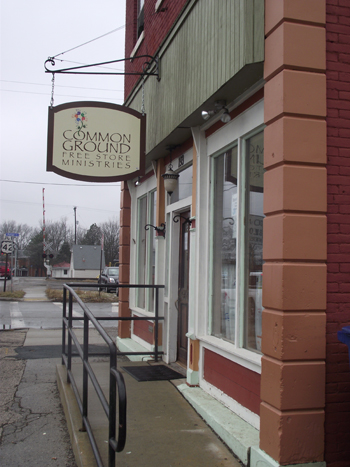
The heavy wooden door swings inward and blows a burst of cold air into the lobby. A man and a woman enter, dark hair matted with snowflakes. They rub their hands together briskly while taking a seat on the left side of the store.
“Get them a paper towel for their heads,” instructs the woman to my right. “They look freezing. Maybe you two would also like a cup of coffee?”
Beth Trigg, assistant director of the store, slowly sips her own hot beverage as she greets the visitors. She’s wearing simple shoes, jeans and a warm red jacket. Her no-nonsense approach to the store is like a mother caring for her children on a Sunday afternoon in the park. When she talks about the store, it’s clear she loves the place.
Trigg, who started as a volunteer more than four years ago, has worked in every capacity at the store. Cleaning toilets, organizing clothing, making pots of coffee and serving visitors have all previously fallen onto her duty list.
She said all of the wonderful volunteers are what makes the Free Store operate, but the patrons make it worthwhile. The store is open to any individual or family,. Pay stubs, social security cards and proof of welfare aren’t necessary for seeking help here.
“All of god’s people are welcome,” Trigg said. “The stories that turn out well are few and far between, but we have a relationship with these people. They’re not just a number.”
When they first enter, shoppers sit in a small lobby. Square black chairs with metal arms offer rest for weary bodies. Coffee, cookies and lemonade are distributed. Peering through the doorway behind the lobby desk offers a view of the hospitality area. Families and individuals are seated at several odd sized chairs. Volunteers enter a small kitchen on the far side of the room to retrieve food.
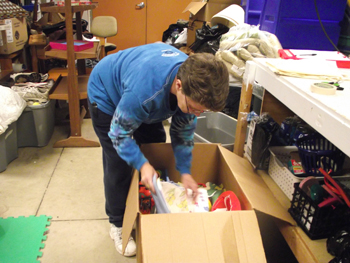
Old men, young children and couples line the lobby walls, waiting to enter the hospitality area where today’s meal of hot dogs, egg salad, and Johnny Marzetti is being served. While guests wait for their turn, the desk attendants catch up on their children’s lives, hear about life on the farm and praise the glory which is UDF ice cream.
One visitor, an elderly man with a weathered ball cap and a blue jumpsuit, sits across from me in the lobby. He says hello to me, then is approached by the woman behind the desk. Her short brown hair barely stirs and her glasses stay firmly perched on her nose as she walks towards him.
“Would you like some coffee today,” she said.
“No, I already had some,” he said. “I forgot my thermos, so I had to drink it real quick like. Do you have anything cold?”
“Why yes, let me get you some lemonade,” she said.
Upon her return he swigs the lemonade in two gulps and says, “Well that’s good. I’m gonna go shop, then maybe have some more of that.”
He hands a small parcel to the woman behind the desk and waits for her reaction.
“Oh, black walnuts,” she said with a smile on her face. “These are good for cakes and the like.”
“Yeah, I was just pickin’ and grinnin’,” he said, revealing the self-same grin.
Thirty minutes later he walked away with a bag of clothes and a wet whistle.
Trigg said that’s why the location is great. Like this man, many of the store’s guests either don’t have cars or money for gas, so they walk. While the organization doesn’t own the corner brick building, she said they’re hopeful that expansion and purchasing a building are in the future.
A short walk through the store highlights the necessity of expansion. Goods are crammed in every nook and cranny of the place. The store offers clothing, household goods, books, videos, shoes and other miscellaneous items to the public. These are spread on shelves, organized in bins, hung from racks and stacked in every corner.

He points out his favorite parts of the store, animatedly highlighting each important section on our walk. Parsons has been working with homeless individuals in the Columbus area for about four years, but said the free store is the best organization of its kind he has seen.
“It’s amazing how many families we’re able to serve,” he said, illustrating his point by showing me the line at the checkout station. “It’s a good social practice. It lets people see the other side of the street.”
With a solid spirit and admiration in his voice, Parsons spoke of two men who entered the store that morning who hadn’t eaten in three days. To him, it’s the little miracles and duties of the store which create immense change and satisfaction. He continued to focus on the good works of the free store throughout the journey. The path we walked through the store, which all shoppers take, began when we exited the hospitality area.
There’s a long hallway off the hospitality area which serves as one of three main shopping areas. To the right are shelves filled with books and videos, bins with clean underwear, and household items like towels, convection ovens and tea kettles. Lining the racks on the other side of the wall are baby clothes, boy’s clothing and girl’s clothing. These two white metal racks, one knee level and the other much higher, are divided by age level.
Leaving the hallway sends the shopper into another world where an elaborate mural covers the play space. Flower tendrils creep up the walls, lush bushes line the baseboards and sturdy oak trees grow around the windows to the outside. A squirrel and a rabbit frolic on one of the trees while grass cushions the feet of the tired shopper.
Tonka trucks have been tossed on the floor by the last child to come through. Bookcases are filled with smiling teddy bears and board games. These toys are calling out, waiting to be picked up and loved by a child in need. The toy room appears to be one of the more well-used sections of the store, because children linger and play.
Since there is a 15 minute shopping limit to ensure access to all shoppers, the children are unable to linger very long before making their toy selections and moving into the next room with their parents.
The next and final room of the store houses the adult male and female clothing racks. Similar to the set up in the hallway, three walls are lined with two tiers of clothing racks. Rather than age, these racks are organized by type. Dresses and skirts are on the right, sweaters and pants are across from the door. A central shelved island filled with shoes completes the visit for many. Next to the exit, two volunteers staff a long checkout station where items are counted, bagged and taken off of a shopper’s monthly limit.
20 articles of clothing, 8 accessories, 4 toys, 4 household items, 10 books and 1 winter coat. These are a few of the “per person” totals adhered to. Last year, the store distributed 57, 236 articles of clothing and 9,939 diapers, among a multitude of other things.
These numbers seem high until you hear that the store serves anywhere from 40 to 90 families each of the three weekdays it’s open. With so many families served, and 986 new families added in 2011, it’s hard to believe the racks are stuffed with clothing every day. Until you enter the back room.
The organized chaos which is the back room is evidence of the store’s productivity. Two large tables in the center provide a flat surface for volunteers to sort items and clothing. Three walls of the space are lined with large wooden shelves, towering up to the high ceilings. This place is the miniature warehouse which feeds the store. Crates, bins, boxes and bags are on the shelves. Some have hats, appliances, clothing, shoes, art supplies and even spare cups for the hospitality area. Opening the Employees Only door reveals a hornet’s nest of activity and for today, Wanda Davenport is the queen bee.
Davenport began volunteering at the store 15 months ago when she took her daughter’s place for the day. While she said she usually likes to stay out of the limelight, she admitted that she’d talk to anybody if it was about the store.
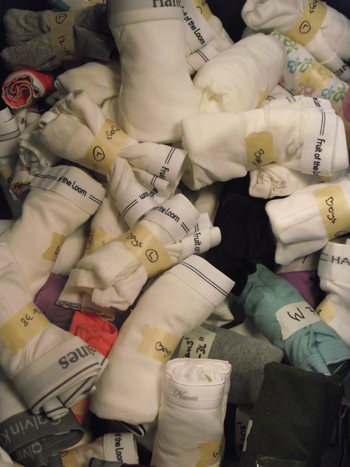
“This really is the coolest place,” she said. “The first day is confusing, but after that you’ll love it. When you think about the services we offer, it makes you realize that without us, some of these people would have nothing.”
Aside from the volunteers and the donations, Davenport said the children who come to the store are her favorite part.
“The kids are the greatest,” she said, while continuing to unpack boxes. “They’re really good and have a lot of fun. My 6 year-old granddaughter even volunteers here.”
In addition to the boisterous children, she said some of the most amazing events have occurred which make volunteering worthwhile. One day a young woman came in who was set to be married in a short while. Her August wedding was set for the beach and her colors had all been chosen. She walked into the store and found the perfect white dress, paired with a complimentary jacket. Several days later the store received flowers and boutonnieres. They were the bride’s colors.
“Now, you tell me where else something like that could happen,” Davenport said, raising her eyebrows and smiling wide beneath her glasses.
Volunteers like Trigg, Parsons and Davenport have helped the store function and grow, but a variety of events entice shoppers to come together for community bonding several times a month. A monthly bingo night is held for registered shoppers. The prizes of toilet paper and laundry soap may seem unrewarding for the average reader, but these items are vital for the families who visit the free store. The bingo prizes are provided by sponsoring churches, which also offer babysitting services during the event, and are items which can’t be purchased with food stamps. On the third Sunday of every month the store also offers an open church service.
Trigg’s passion for the bingo night and the Sunday services is clear. She beamed with pride when she informed me that no one is discouraged from attending or sharing at these services. Anyone with a message in their heart is welcome to share.
As she continued to greet customers, she spoke about the future of the store. The organization would like to expand on these events and become even more involved in the community. A children’s garden in Eastside Park, vacation bible school, a boys fishing event and Mommy & Me classes are on the horizon for the store.
Pausing in her sentiments, Trigg instructed the main door greeter to collect hats and caps from the shelves and put a bin next to the door.
“Silly goose, he needs to pick up a new coat with a hood today,” she said, lightly chastising one of her regular visitors.
For the rest of the afternoon, visitors to the store were offered caps to keep their heads warm in the winter weather.
“I wish I had a nickel for everybody who asks what this store is about,” she said, slowly shaking her head from side to side.
For Trigg and others, the store is a window into the lives of those who need assistance. It is a vehicle of change in the community and a helping hand for those in need. For those who ask, help will always be given at the store. Shoppers, volunteers, churches, donators and community members come together on the common ground this space has created. This is a place of love, caring and acceptance.
For some, the store appears to be on the wrong side of the tracks, in a less fortunate part of town. For the volunteers and the people who visit the store, it is definitely the right side. Perfectly located where it may do the most good, the store opens its doors and stretches its arms out, calling for all to come enjoy the benefits of a warm coat and a hot meal.
Babbling Bishops at it again!

Little Rock Niner challenges the status quo
“Race has no true validity but we act as though it does,” Dr. Terrence Roberts said during a lecture in Benes Room A last Thursday at 7 p.m.
Roberts spoke first-hand about the rules of segregation and the fear that made people abide by them.
He was a member of the Little Rock Nine, a group of African American students who, in 1957, were the first to integrate Little Rock Central High School in Little Rock, Ark.
Gene Sludge and Shelby Austin, co-presidents of the Student Union on Black Awareness, asked Roberts to speak during Black History Month.
Dr. Rock Jones, president of OWU, introduced the speaker to the crowd.
“It’s not often that we have the opportunity to be with a true American hero—a person whose life has helped shape the way society and our lives are lived today,” said Jones.
Roberts was born in 1941 in Little Rock, Ark. He said he anticipated joining a community of people who loved him, but instead, he got a very hard message.
“It’s like people said, ‘Boy, there is something very wrong with you. You are clothed in black and the color is white, don’t you know that?’
“I figured I was in the wrong place,” Roberts said. “It occurred to me there had to be sane people outside of Little Rock, where everyone is insane. Well, I was wrong. Everybody in the United States was totally bonkers.”
Roberts said he quickly learned the difference between life and death and lived by learning the rules of segregation and obeying them.
“From 1619-1954, a 335 year span, we the people thought it’d be best to live compartmentalized lives built on race segregation,” Roberts said, “During that period it was in fact legal to discriminate. Constitutional, if you will, to discriminate in these United States of America. If you are discriminating for 335 years you get good at it; it becomes second nature.”
The 1954 Supreme Court Brown v. Board of Education case was not a popular decision, according to Roberts. One hundred congress members signed the southern manifesto saying, “We will do everything within our power to not permit implementation of this Brown v. Board decision.”
In 1954 Roberts was 13 years old and he said he was overjoyed by the monumental case. The law had changed. Unfortunately, he said, even though the law changed, nothing else changed with it. The social, cultural and ideological hatred remained embedded in the character of the country.
Roberts said he decided he did not have to play by the rules of segregation anymore.
“I was erroneous,” Roberts said. “When you’re 13, you do things. You just don’t think as you would as an ordinary human being. I violated one of the sacred laws of segregation. Chrystal Burger hamburger joint was a white owned restaurant, but they let black people go through the front door.
“I usually walked in, made my order, and it was always to go—the cardinal rule was blacks couldn’t sit down. Someone once joked that the way to end problems in the south would be to ‘get rid of all the seats.’ Anyway, I ordered a burger and fries and sat down. Immediately everything in the Chrystal Burger stopped as if someone has pushed pause on a VCR. All heads swiveled towards me. No words were spoken, but the nonverbal message was palpable. ‘Boy you better get some sense in your head.’”
Roberts said he suddenly awoke and realized what had happened. He cancelled his order and ran out.
“Something snapped inside me,” Roberts said. “I cannot continue to pretend to obey these rules. The year 1954 looms large in my head.”
Roberts said he remembers a boy being killed in Money, Miss., because he allegedly whistled or winked at a white female.
“He was savagely murdered.,” Roberts said. “His brutalized body displayed for the universe to see because his mom insisted on that. I was afraid I would wind up that way. There were so many stories like that.”
Two years later he joined the Little Rock Nine. Initially, there were more than nine. At a school assembly, Roberts said 150 students volunteered.
“The count was in fact off by one because I had both hands up,” Roberts said. “Then everyone went home– kids rethought their situation and parents vetoed the idea.”
Then there were 10 people left. Jane Hill was the student who left. According to Roberts, her dad got an employee call threatening to fire him if he sent Jane to school, so he pulled her out and lost his job anyway.
“He crossed the line just thinking of sending his daughter,” Roberts said. “People without kids in school lost jobs.”
Roberts said the most amazing thing to him was to watch the kids treat him and his friends with such disdain, as if to say, ‘we have the right to abuse you, don’t you know?’
“Even though we hadn’t discussed it together, the nine of us were committed,” Roberts said. “I’m pretty sure we all thought death was preferable to life under segregation. We were all eager to go to school; we loved school.”
The governor, however, was not eager to integrate. He called the National Guard to keep the children out and they did. Roberts and the other eight called the Little Rock police. He said he was almost killed that day.
“The situation was so dire that there was some talk of letting the mob hang one kid in order to get the other eight out,” Roberts said.
The third time the Little Rock Nine showed up to school, they were able to enter the building.
“Eisenhower sent in the army to help,” Roberts said. “Not because he cared about our welfare, though. The Arkansas governor had made noises about ceding from the union. But it’s okay to be a secondary beneficiary.”
With the army at his side in school, he said he and his friends still were almost killed. Children would run behind him, push him down the stairs and hit him with urine-filled balloons. He recalls being bruised and battered daily.
“The nine of us took a vow of nonviolence,” Roberts said. “It didn’t work like I thought. We were seen primarily as stationary targets. Running was my default option. I enjoyed running away. My mom once told me that lower animals like rats and cats and dogs fight because they can’t talk and negotiate so why would I ever want be like a rat?’ So I took my humanity and ran with it.”
The army was there until the end of year, according to Roberts. One boy graduated and the other eight were not allowed to attend because it was too dangerous. The next year, the six-time re-elected governor closed down all public high schools in Little Rock.
“I met the governor not too long ago,” Roberts said. We both appeared on Good Morning America. Backstage, I confronted him. ‘Your actions could have killed all nine of us.’ He said he had to do it otherwise he would not have been re-elected.”
Roberts said he went to Los Angeles, Calif., to live with his Grandma when the schools closed in 1958, and he persuaded his family to move there a few months after too.
“I technically am Californian at this point,” Roberts said. “I don’t pledge allegiance to geography, though. I am a citizen of the universe.”
At this point, Roberts began to accept questions, but there were rules.
“When asking questions, you are not allowed to use the word like,” Roberts said. “We are going to work on that tonight. This is your opportunity stop cold turkey. Stand and speak with your diaphragm.”
A student in the front row of the room asked, “Um why don’t you believe in race?”
Roberts’s response—“You have now been relieved of the need to say um.” He continued to say that the word race itself is new to the lexicon. It was first recorded in 1530.
“A group of pseudo-scientists developed it with a hierarchy from white to black and sold it to we the people and we bought it without thinking about it,” Roberts said. “Scientifically there has never been any such thing as a race. Every single human in the universe is unique.
“No one has been you and no one will be unless the people that got a hold of Dolly the sheep get a hold of you. Difference is the one thing that confuses us so we grab onto race. You too are a citizen of the universe. But we confuse it with all kinds of little lines.”
Another student asked, “Why is there still racism?”
Roberts said that even though slavery was abolished legally, it did not stop.
“If people wanted to change, we could,” Roberts said. “If you can do nothing else you can change you. Most people like to coast through life. You run the risk of being judged never to have lived. I take the best each person has to offer of whomever I am with and I let the trash go.”
Students also inquired about the importance of education to inner city black men.
Roberts said he was sent to school at the age of six. His first grade teacher said he had to become CEO of his own independent learning enterprise.
“When you take on executive responsibility nothing gets in the way of learning,” Roberts said. “You make decisions hourly to make it all happen. We need to find out more answers. It is imperative that we don’t buy the first thought that comes. We should challenge it and dig deeper.”
At the end of the Q & A, Roberts was presented with a book by an OWU class of ’82 alumnus, Byron Pitts. The book, called “Step Out on Nothing: How Faith and Family Helped Me Conquer Life’s Challenges,” was signed by Pitts and by everyone in the audience for Roberts to take away as a memory from his experience at OWU.
Strand prices change, but the tradition still remains
The Strand Theater has provided the cinematic experience for locals and students for many years. The theater also has had close ties to Ohio Wesleyan since 2002.
“In 2002, Ohio Wesleyan took over ownership of the theater,” said manager Kara Long. “Then in November of 2008, they formed a separate non-profit group called The Strand Theater and Cultural Arts Association. It’s a fifteen member board of directors. Now we have the ability to fundraise on our own and get grants to keep the building up.”
Prior to OWU taking over The Strand, “(Business) was very slow,” Long said. “I changed film buyers when I took over in 2002. We were not getting our fair share of movies. The previous owner’s film buyer was not fighting. So, I found one that would say, ‘That’s not fair, we have every right to make money as anyone else in town.’”
The Strand Theater and OWU still maintain a close relationship.
“Of the fifteen board members, Ohio Wesleyan appoint eight, so they kind of retain a little bit of control,” Long said. “It was a good thing, if anything would go wrong – if the wheels would come off the bus, as they say – they could pull it back under. It’s a kind of safe guard.”
Upon returning to campus last semester, students noticed the change in price at The Strand. Previously, with an OWU ID, students could get in to see a movie at any time for four dollars. On August 1, that price went up to five.
“The studios have limits on us, called per capita, where they set in their minds, in Hollywood or New York, how many tickets at what price you should sell,” Long said. “We had way too many coming in at four dollars. The high school students were already five dollars, so it was the logical step. It made the studios get off our back. It’s the last thing you want to have, the studio on your back, looking at your prices. They can’t tell you what to charge, but they can make life difficult.”
Taylor Clark, 18, has been employed at The Strand since 2008.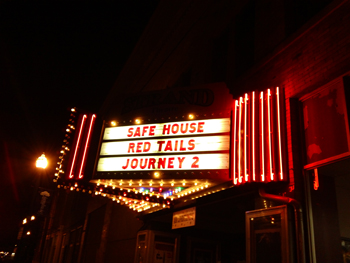
“My mom and my grandma also worked here,” Clark said. “It wasn’t planned that I work here, it just happened. It was just irony.”
Clark said she loves working at The Strand.
“Working in a historical building (is the best part),” Clark said. “You learn a lot about film, which not many people know much about. This is like a Delaware classic thing, so it’s nice to know the insides of it.”
Clark said if she had to choose between seeing a movie at The Strand or a bigger theater like the Rave in Columbus, she would choose The Strand.
“Much cheaper, and it’s homey,” Clark said.
Sophomore Lauren Foote said she would rather see a movie at The Rave.
“If it didn’t count on price?” Foote said. “The Rave. Just because it is a lot bigger, and a lot more options. I can watch 3-D movies or movies The Strand doesn’t have.”
Foote also spoke about the advantages of the historical theater.
“It’s affordable, it’s on a very close street to campus, so if I want to go see a movie I can drive and it take six seconds or I can walk with friends,” Foote said. “It shows recent movies, it’s not like narrow indie films. They show movies that are actually out. And they have good popcorn.”
However, Foote said, there were a few draw backs to the Strand.
“It could be a little bit bigger,” Foote said. “They only have three rooms, and the seats are a little outdated. A little bit of refurnishing would be helpful. Otherwise, (I don’t have) many complaints about The Strand.”
Long assists the film buyer in choosing which films to show.
“Her and I consult every Monday on what’s coming and going,” Long said. “Sometimes I know like on March 2 we’re going to get Project X and The Lorax, but I don’t know what the third picture will be.
“Next week, I know we’ll be picking up The Artist for next Friday, I don’t know what the other two films will be. This time of year, we just go to boxofficemojo.com, and let’s say I have requests, so we pull them in… This time of year is when we get the chance to pull in the Oscar stuff. Once we get past the first weekend of May, then the gloves come off and we start first run.” Long said
The Strand Theater is located on Winter Street, and students can find show times, upcoming movies and events at their website: http://www.thestrandtheatre.net.
New food court to feature low cost changes
The Hamilton-Williams food court is long overdue for a face-lift. Neither furniture nor equipment has been replaced since the campus center was built 20 years ago.
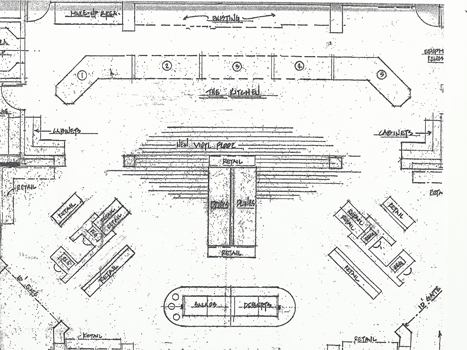
The renovated food court will serve much of the same food, keeping the sushi, sandwich, Healthy Bishop and salad stations. But it will also bring change, incorporating more brand-name food.
This would allow for more variety and convenience. A Papa John’s pizza station will allow students to quickly grab individual-sized pizzas. Chartwells is also deciding between two local brands to replace the current grill station.
The school has been reluctant to involve brand-name products in the past because most companies demand commissions. So far, Starbucks and Coca-Cola are the only brand-names on campus.
The food court’s layout will change as well. The same architect who planned Smith Dining Hall drafted the new floor plan.
The renovations aim to increase efficiency, angling the cash registers so students can flow through more easily. These changes also affect the dining areas, which will look different without losing seating.
Castelli said the renovation would cost $500,000 – $600,000, a modest budget compared to recent projects.
“Considering the school spent $13 million on Stuyvesant, this amount doesn’t seem like much,” Castelli said.
This project would cost less than previous dining hall renovations. Smith Dining Hall was given $1 million for its renovation in 2007.
Senior Eric Charette said he remembers how Smith Dining Hall looked before the changes.
“I had dinner in Smith as a prospective student, and it was disgusting then,” Charette said. “When I came back in the fall, I recognized the renovations immediately because it was so starkly different.”
In fact, a survey conducted soon after the renovations showed a 41 percent increase in student satisfaction of Smith Dining Hall.
The food court renovation is only one of Chartwells’ proposed campus changes. Castelli also mentioned the Thomson Convenience Store might be remodeled within a few years, although current students should not expect to see these changes soon.
Sophomore Ariel Koiman has worked extensively with Chartwells as a WSCA Representative.
He said he is looking forward to the renovations, and thanked Chartwells.
“I think it’s an excellent idea” Koiman said. “They’re doing the renovations for us. Honestly, I don’t know how they make a profit.”
